
The Sphingidae are a family of moths (Lepidoptera) called sphinx moths, also colloquially known as hawk moths, with many of their caterpillars known as “hornworms”; it includes about 1,450 species. It is best represented in the tropics, but species are found in every region. They are moderate to large in size and are distinguished among moths for their agile and sustained flying ability, similar enough to that of hummingbirds as to be reliably mistaken for them. Their narrow wings and streamlined abdomens are adaptations for rapid flight. The family was named by French zoologist Pierre André Latreille in 1802.
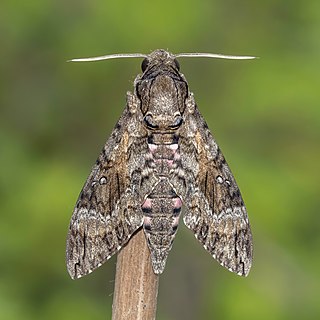
Agrius cingulata, the pink-spotted hawkmoth or sweetpotato hornworm, is a moth in the family Sphingidae. The species was first described by Johan Christian Fabricius in 1775.
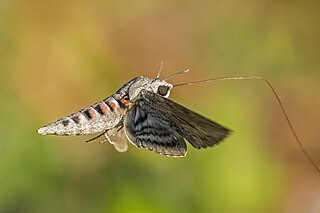
Agrius convolvuli, the convolvulus hawk-moth, is a large hawk-moth. It is common throughout Europe, Asia, Africa, Australia and New Zealand, partly as a migrant. In New Zealand, it is also known as the kumara moth, and in the Māori language as hīhue.
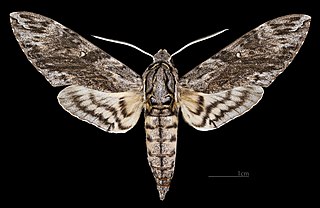
Agrius godarti is a moth in the family Sphingidae which is found inland in the northern half of Australia, including Queensland and New South Wales.

Agrius is a genus of moths in the family Sphingidae. The genus was erected by Jacob Hübner in 1819.

The Sphinginae are a subfamily of the hawkmoths (Sphingidae), moths of the order Lepidoptera. The subfamily was first described by Pierre André Latreille in 1802. Notable taxa include the pink-spotted hawkmoth, being a very common and recognizable species, the death's-head hawkmoths of Silence of the Lambs fame, and Xanthopan morganii with its enormous proboscis.
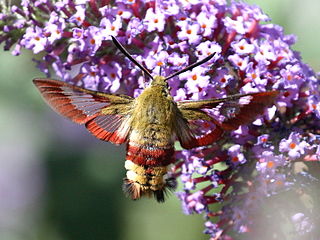
Hemaris fuciformis, known as the broad-bordered bee hawk-moth, is a moth of the family Sphingidae.

Amphimoea is a monotypic moth genus in the family Sphingidae erected by Walter Rothschild and Karl Jordan in 1903. Its only species, Amphimoea walkeri, the Darwin hawkmoth, described by Jean Baptiste Boisduval in 1875, is found from Mexico south to Argentina.

Agrius luctifera is a moth in the family Sphingidae. It is found in Indonesia and New Guinea.
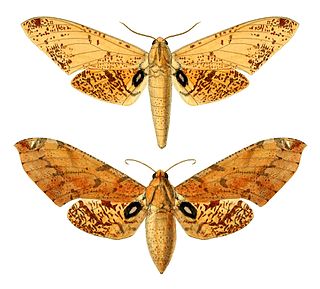
Platysphinx stigmatica is a moth of the family Sphingidae. It is known from forests from Nigeria to the Congo, Angola and western Uganda.

Basiothia schenki, the brown striped hawk, is a moth of the family Sphingidae. The species was first described by Heinrich Benno Möschler in 1872. It is known from Zimbabwe and South Africa.
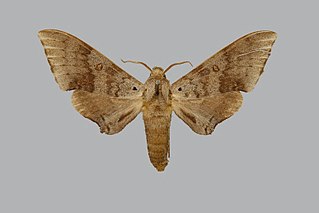
Neopolyptychus prionites is a moth of the family Sphingidae. It is known from lowland forests and heavy woodland from Guinea to the Congo and western Uganda.
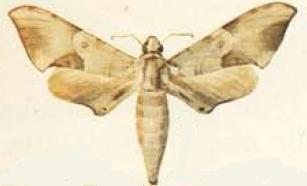
Neopolyptychus compar is a moth of the family Sphingidae. It is known from Brachystegia woodland from Zimbabwe to Mozambique, Zambia, Malawi and south-eastern Tanzania.

Cephonodes rothschildi is a moth of the family Sphingidae. It is known from the Star Mountains in Papua New Guinea.
Xylophanes blanca is a moth of the family Sphingidae. It is known from Peru.

Xylophanes fassli is a moth of the family Sphingidae.

Xylophanes ockendeni is a moth of the family Sphingidae. It is known from Peru.

Xylophanes rothschildi is a moth of the family Sphingidae. It is found from Colombia, Ecuador and Peru south to Bolivia.
Agrius cordiae is a moth of the family Sphingidae. It is known from the Marshall Islands.

Marumba amboinicus is a species of moth of the family Sphingidae. It is known from Indonesia and the Philippines.

















